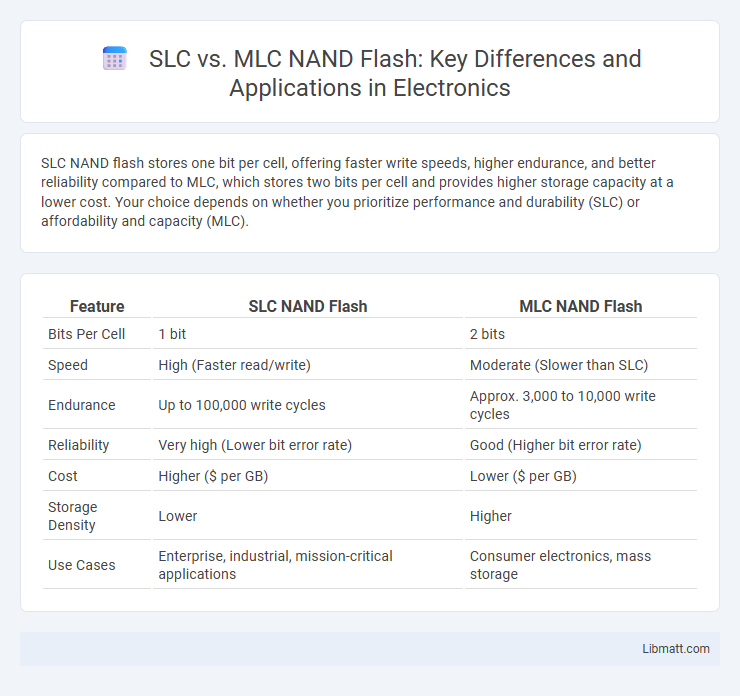SLC NAND flash stores one bit per cell, offering faster write speeds, higher endurance, and better reliability compared to MLC, which stores two bits per cell and provides higher storage capacity at a lower cost. Your choice depends on whether you prioritize performance and durability (SLC) or affordability and capacity (MLC).
Table of Comparison
| Feature | SLC NAND Flash | MLC NAND Flash |
|---|---|---|
| Bits Per Cell | 1 bit | 2 bits |
| Speed | High (Faster read/write) | Moderate (Slower than SLC) |
| Endurance | Up to 100,000 write cycles | Approx. 3,000 to 10,000 write cycles |
| Reliability | Very high (Lower bit error rate) | Good (Higher bit error rate) |
| Cost | Higher ($ per GB) | Lower ($ per GB) |
| Storage Density | Lower | Higher |
| Use Cases | Enterprise, industrial, mission-critical applications | Consumer electronics, mass storage |
Introduction to NAND Flash Technology
NAND Flash technology is a type of non-volatile memory commonly used in SSDs, USB drives, and memory cards, where data is stored electronically without power. SLC (Single-Level Cell) stores one bit per cell, delivering faster speeds, higher endurance, and better reliability, while MLC (Multi-Level Cell) stores multiple bits per cell, increasing capacity at a lower cost but with reduced performance and durability. Understanding the distinctions between SLC and MLC NAND Flash helps you choose the right storage solution based on speed, longevity, and budget requirements.
Understanding SLC (Single-Level Cell) NAND Flash
SLC (Single-Level Cell) NAND Flash stores one bit of data per cell, providing superior endurance, faster write speeds, and lower power consumption compared to MLC (Multi-Level Cell) NAND Flash. This makes SLC ideal for enterprise-grade applications and industrial use where reliability and speed are critical. Your choice of SLC NAND Flash ensures enhanced performance and longer device lifespan in demanding environments.
Understanding MLC (Multi-Level Cell) NAND Flash
MLC (Multi-Level Cell) NAND Flash stores multiple bits per cell, typically two, enhancing storage density compared to SLC (Single-Level Cell) NAND, which stores only one bit per cell. This architecture increases capacity and reduces cost per bit but results in slower write speeds, higher error rates, and reduced endurance. MLC NAND Flash is widely used in consumer electronics and SSDs where storage efficiency and affordability are prioritized over maximum performance and longevity.
Key Differences: SLC vs MLC NAND Flash
SLC (Single-Level Cell) NAND Flash stores one bit per cell, offering higher endurance and faster write speeds compared to MLC (Multi-Level Cell) NAND Flash, which stores two or more bits per cell, maximizing storage density and reducing cost. SLC exhibits lower error rates and longer lifespan, making it ideal for enterprise and industrial applications requiring reliability, while MLC balances cost and capacity for consumer electronics. The choice between SLC and MLC impacts performance, durability, and price, influencing SSD design and usage scenarios.
Performance Comparison: Speed and Latency
SLC NAND Flash offers significantly faster read and write speeds with lower latency compared to MLC NAND due to storing a single bit per cell, resulting in simpler data states and quicker data access. MLC NAND stores multiple bits per cell, which increases data density but also introduces slower write speeds and higher latency as error correction becomes more complex. Consequently, SLC is preferred for high-performance applications requiring ultra-fast speed and minimal latency, while MLC provides a more cost-effective solution with moderate performance.
Endurance and Lifespan Analysis
SLC (Single-Level Cell) NAND Flash offers higher endurance with typically around 100,000 program/erase cycles, while MLC (Multi-Level Cell) NAND Flash endures approximately 3,000 to 10,000 cycles, impacting overall lifespan. The increased cell complexity in MLC leads to faster wear-out and reduced reliability compared to SLC, which stores one bit per cell, enhancing data retention and durability. For applications demanding long-term data integrity and frequent write operations, SLC NAND Flash provides a superior lifespan and endurance profile.
Reliability and Data Integrity
SLC NAND Flash offers superior reliability and data integrity due to its single-bit storage per cell, resulting in lower error rates and longer endurance with up to 100,000 program/erase cycles. MLC NAND Flash stores multiple bits per cell, increasing data density but reducing reliability with an average of 1,000 to 10,000 program/erase cycles and higher susceptibility to cell wear and data corruption. Error correction code (ECC) mechanisms are essential in MLC devices to maintain data integrity, but SLC remains the preferred choice for mission-critical and enterprise storage applications.
Cost Considerations: SLC vs MLC
SLC NAND Flash offers higher durability and faster performance but comes with a significantly higher cost per gigabyte compared to MLC NAND Flash. MLC provides a more cost-effective solution by storing multiple bits per cell, increasing storage density and lowering price, though it sacrifices some speed and lifespan. You should weigh the balance between budget constraints and required reliability when choosing between SLC and MLC NAND Flash.
Common Use Cases and Applications
SLC NAND Flash is commonly used in applications requiring high endurance and reliability, such as enterprise storage, industrial systems, and mission-critical data centers. MLC NAND Flash is suited for consumer electronics, including smartphones, USB drives, and solid-state drives, where cost-effectiveness and higher storage density are prioritized. Your choice between SLC and MLC will depend on the specific performance and durability needs of your device or system.
Choosing Between SLC and MLC NAND Flash
Choosing between SLC and MLC NAND Flash depends on the specific application requirements, with SLC offering higher endurance and faster write speeds suitable for industrial and enterprise use, while MLC provides greater storage density and cost-efficiency ideal for consumer electronics. SLC NAND Flash typically endures up to 100,000 write cycles per cell, significantly outperforming MLC's average of 3,000 to 10,000 cycles, making SLC more reliable for critical data storage. Evaluating factors such as performance needs, budget constraints, and data retention priorities ensures the optimal selection between these NAND flash types.
SLC vs MLC NAND Flash Infographic

 libmatt.com
libmatt.com